Tamagoyaki (玉子焼き) is made by pan-frying thin layers of eggs and rolling them into a log, often using a special rectangular tamagoyaki pan. In Japan, it is enjoyed at any time of the day—from breakfast to bento lunches, or as a nice side dish for dinner. Tamagoyaki is a simple dish made with basic ingredients, but it plays a significant role in Japanese cuisine and is frequently seen in meals.
History of Tamagoyaki
The history of tamagoyaki (Japanese rolled omelet) is surprisingly short, said to be around 100 years, despite being deeply rooted in modern Japanese cuisine. For a long time, Japan did not have a custom of eating chicken eggs. However, around the 1600s, with the introduction of Western confectionery through trade with Europe, desserts using eggs began to appear. By the mid-Edo period (1603−1868), egg-based dishes gradually started to spread. It wasn’t until the Meiji era (1868-1912) that egg dishes became truly widespread, and tamagoyaki itself is believed to have emerged around 100 years ago.
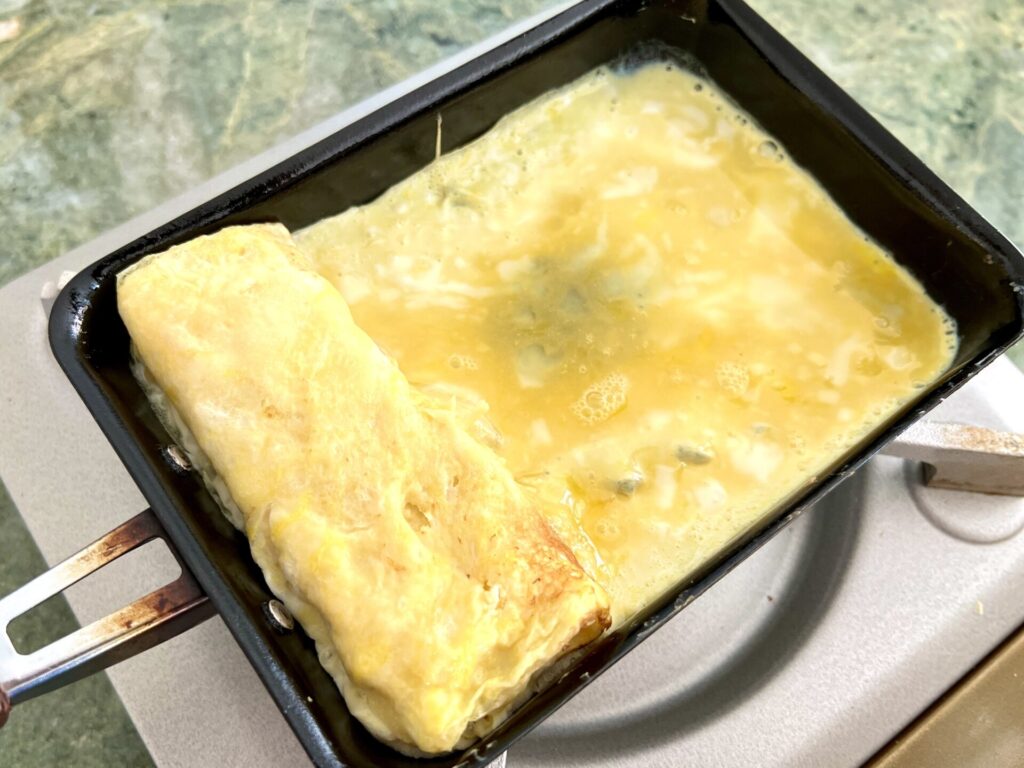
What does Tamagoyaki Taste like?
Tamagoyaki is seasoned differently depending on the region and even by each household. Generally, the eastern part of Japan (Tokyo or Kanto region) uses more sugar for flavoring, as seen in Sushi egg, making it often very sweet. On the other hand, western Japan (Osaka or Kansai region) emphasizes dashi and salt, often serving it with grated daikon radish, resulting in a much more savory flavor. The appearance of tamagoyaki also varies by region. Due to the sugar content in the Kanto style, it tends to have grill marks, while Kansai-style tamagoyaki is typically pale.
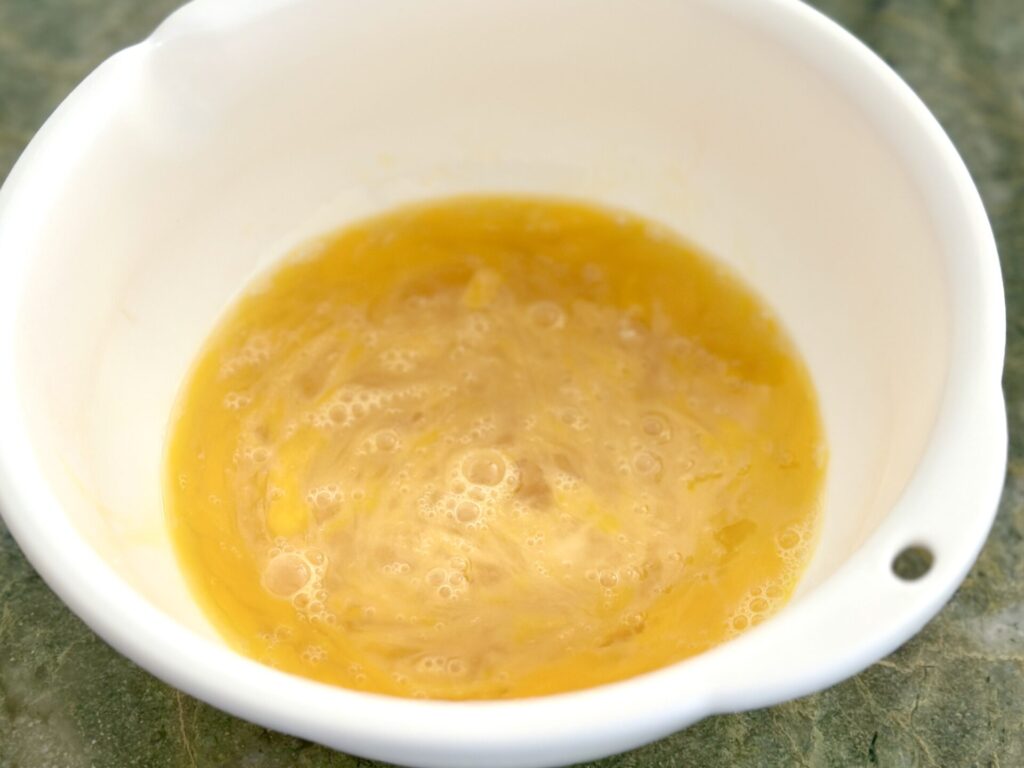
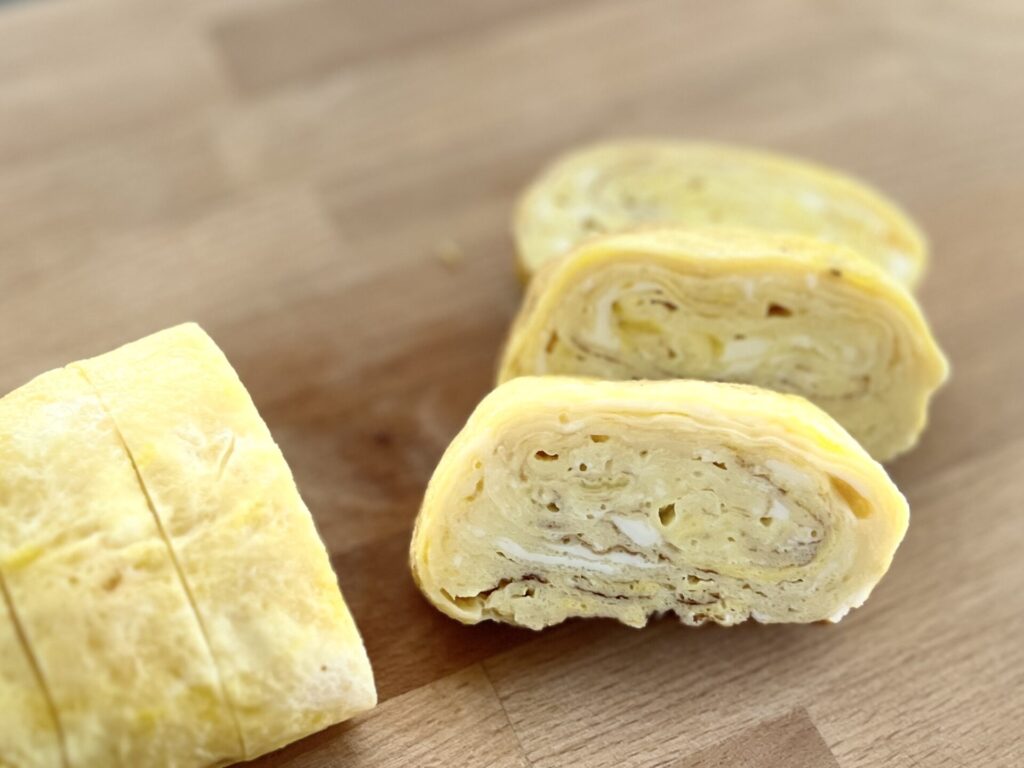
Ingredients and substitution
Our recipe is closer to the Kansai style, but we use mirin to lightly sweeten the eggs. If you prefer your tamagoyaki to be sweeter or even more savory, you can adjust the seasonings to suit your taste.
- You can use up to 1 tablespoon of sugar per egg and omit the mirin. However, this will make it quite sweet, so be sure to adjust the amount accordingly. Be aware that eggs with sugar can brown quickly
- Soy sauce adds a nice salty flavor and can be used in place of salt. Keep in mind, though, that it will make the tamagoyaki a darker color.
- Feel free to adjust the amount of sweetener and salt/soy sauce to balance the flavors to your liking.
Tips and variations of Tamagoyaki
- Use a rectangular tamagoyaki pan to achieve the best results. It’s easier to cook and roll the eggs while maintaining a neat, square log shape. If you’re using an iron tamagoyaki pan, be sure to season it well with oil to develop a slick, non-stick surface.
- Even with a well-seasoned pan, the egg layers may stick while cooking tamagoyaki. To prevent this, apply oil to the pan with a paper towel before each roll.
- If you don’t have a tamagoyaki pan, you can use a regular round frying pan (about 8 inches). The finished tamagoyaki may not look as neat as one made with a specialized pan at first, and you may need to do some trimming, but with practice, you can achieve a similar result.
- When beating eggs, avoid completely homogenizing the egg yolks and whites. Incorporating too much air will make the eggs difficult to roll and result in a coarse texture.
Breakfast menu with Tamagoyaki
More Tamagoyaki recipes
Video
A full recipe video is also available in the recipe box below and on our YouTube channel.
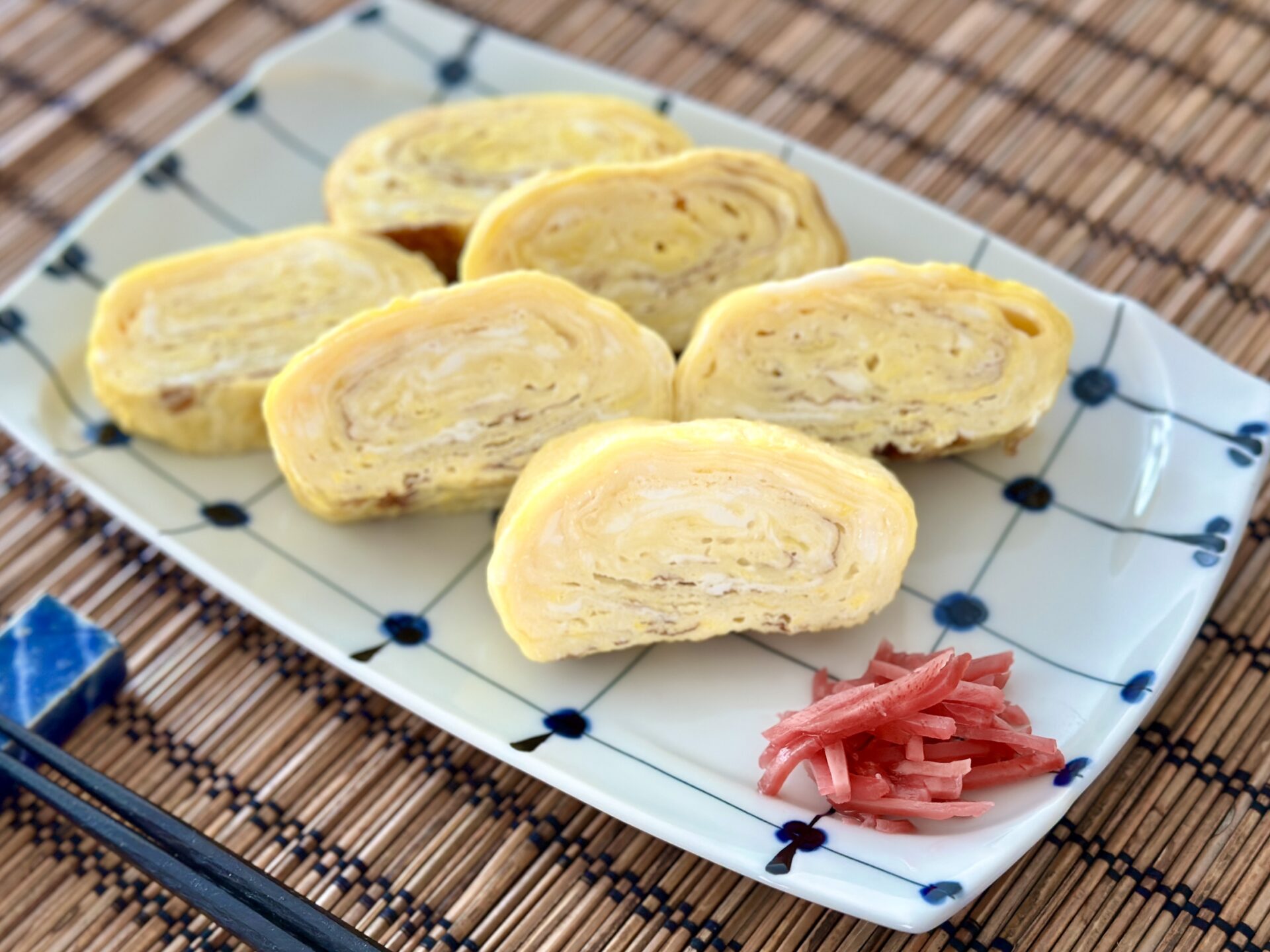
Tamagoyaki (pan fried rolled egg)
Equipment
Ingredients
Instructions
- Mix eggs, salt, soy sauce and Mirin in a bowl.
- Heat a pan at medium high temperature and add oil. (A rectangular Tamagoyaki pan is best, but a round pan can work as well.)
- Pour a thin layer of egg mixture in the pan, tilting to cover the bottom of the pan. After the thin egg has set a little, gently roll into a log. Start to roll when the bottom of the egg has set and there is still liquid on top. If you let the egg cook too much, it will not stick as you roll the log. Now you have a log at one end of the pan. Pour some more egg mixture to again cover the bottom of the pan, with the roll of egg at the end. After the new layer has set, roll the log back onto the the cooked thin egg and roll to the other end of the pan.
- Repeat adding egg to the pan and rolling back and forth until the egg is used up.
- Remove from the pan and cool for 3-4 minutes.
- Slice the ends of the log off and then slice the log into 1/2″ pieces. You should see a nice spiral pattern in the cross section of the egg.
Video
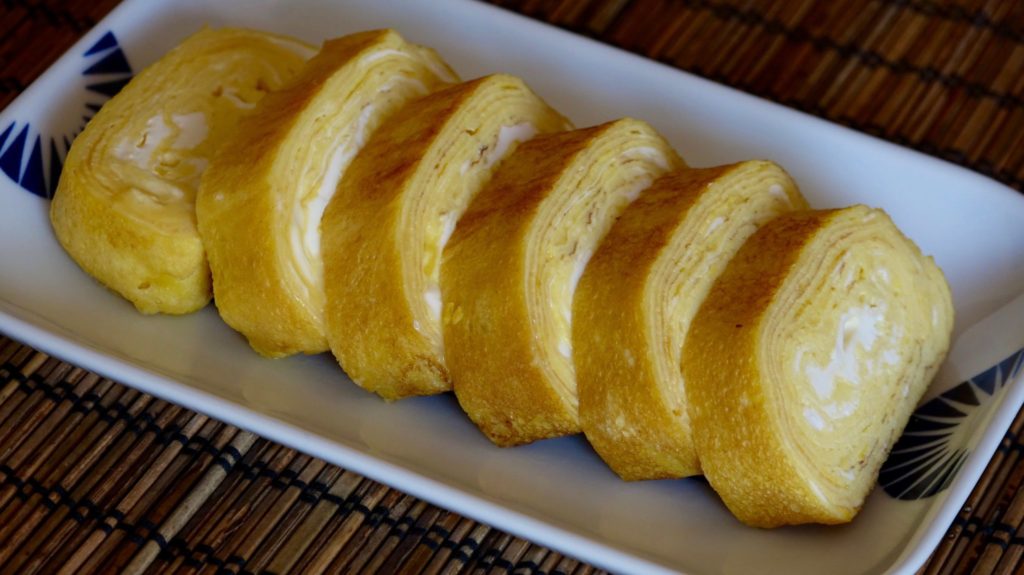
This recipe was originally published in April 2012. The post was updated on February 5, 2025 with more useful content, new photos and a short video.
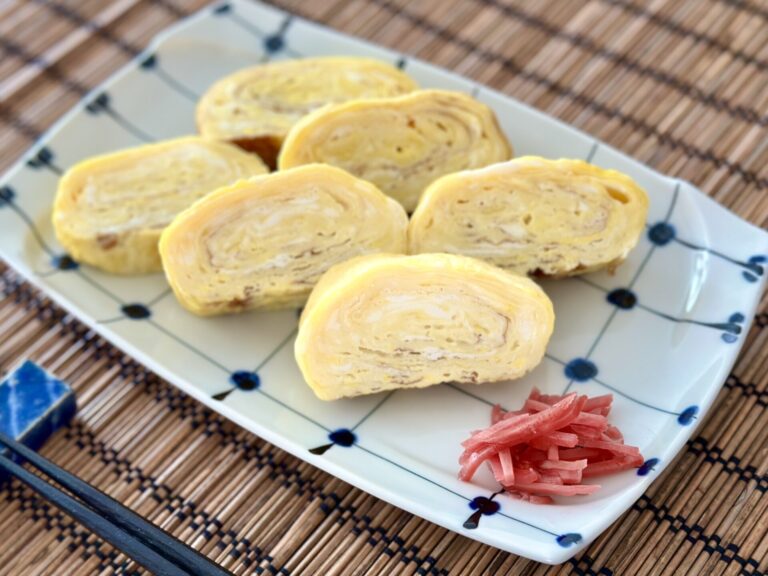


60 Comments
Hi! I just came across your blog! You have some really great pictures, and I love the instructional videos, I can’t wait to make some of these Japanese recipes! Thanks!
Hi Katrina,
Thanks for your really nice comment! We would love to hear your feedback after you try our recipe too!
Thank you!
I have been looking for Japanese recipes and found this site. It is clear as you say cooking 101. Thanks for sharing the recipes.
Shirley,
thanks!
Another alternative to a Tamagoyaki Pan is a small stainless steel or aluminum bread pan. I am trying it out now to see how it turns out, I’ll post my results when I am finished.
Jonathan,
thanks for trying!
I was stationed in the army at the finance building in Tokyo. I had a Japanese girlfriend. We ate Japanese food all the time especially the Japanese omelet. I remember we added onions to the reice mixture. We rolled the egg added onions and the rice inside of the egg mixture. I ame ready to eat breakfast and I was thinking about eating a Japanese omelet with added features. By the way I also operated a military Japanese hotel in gotanda and we also cook those types of eggs. Also I was able to speak perfect Japanese but now ican speak a little after all I am 86 years old thank you
Harold,
thanks for your interesting story! Japanese girl friend and omelet, very sweet!
I found your site when I googled for Japanese recipes. My Japanese Sister-in-law introduced me to this food and I love it. I want to learn how to cook it as well as she did.
Donna,
get your Tamago pan and cook it up!
Thank you sooo very much for all the recipes I just tried making the tamagoyaki and failed the first time the egg didn’t cook all the way so I tried again and much better but on a round pan is hard I just ordered the tamago pan hope it’s easier but a couple questions can you eat it cold? I’m an anime fan and I always see them eating their bento meals but I always wondered is the food warm or cold? Silly question… but I’m really getting into Japanese food and I want to take with me to school and work so I wondered if its ok or if it would go bad? Same with all the other food that you can take in a bento… What can I do or how can I set up my bento? Thank you again I can’t wait to try your other recipes!!
Ana,
Bento is usually room temperature. So yes, you can eat Tamagoyaki cold.
You can easily make this in a non-stick bread pan. I just made one very easily. US grocery stores sell these for about $8. They are multipurpose, too. No need for a special pan. You can also do it on a round non-stick griddle, which is also a multipurpose pan.
I used a round stone pan and it worked just fine. The pieces from the edges of the egg roll looked different than the rest of the rolls, though.
Anyhow, I tried cooking it for breakfast and my parents liked the better presentation and different approach from our usual omelet.
Thanks, Noriko and Yuko!
Bernard,
thanks for making it!
I went to Amazon and found a whole bunch of Tamagoyaki Pans I have gotten 2 different ones and they both work great!
Ryan,
sounds good! Keep on cooking!
I saw the lifestyle of high school students in anime (I love anime ^-^), and I became interested in the food that was cooked for them! Now I’m into Japanese cuisine and I find them unique and great. Thank you for making this website, now I can try cooking them!
Farynor,
when you see food in anime, it looks so good, I wonder why. I had a similar experience with western food in some anime, too.
I enjoy making tamagoyaki. About a month ago, I bought a new ceramic tamagoyaki pan from Japan and I like the pan very much. I can make very good tamagoyaki by using that pan. I thank you people very much for sharing the tamagoyaki recipe. It is very easy to make.
George,
glad you liked our recipe!
Hi. I’ve always been interested in the Japanese culture so when I wanted to learn how to cook Japanese style dishes and google brought me here I was very impressed with it. I will continue to try to make more dishes and am happy I found this site. Keep up the great work!
Tyler,
thanks! Come back soon!
I love you kind your voices are, and just how energetic you are. It’s quite infectious!! The food turns out amazing, too. Thank you so very much for putting in so much time to help others! Thank you thank you 🙂
Amber,
thanks! Come back for many other recipes!
Thanks so much for posting this video! I am going to make tamagoyaki this week. 🙂
Shannon,
hope you liked it!
I’m gonna make it tomorrow. – What kind of oil do you use to cook it?
Fabio,
we use vegetable oil like canola.
I just made the recipe for my family they loved it they want me to make it every morning thank you 🙂
Amber once you know how to make Tamagoyaki, it’s not so hard and doesn’t take much time either.
Um is soy sauce required or can I just leave it out, soy sauce is salty so I can I use salt in its place.
Matthew,
if you don’t like it salty, cut back the amount of salt.
I tried your recipe this afternoon as a snack – and it was really good!
Sadly, I had to use eggbeaters for half of it since I ran out of eggs, and prepared it in a round pan, but sure was delicious!
Thank you for sharing your recipe!
Miki,
glad you liked our Tamagoyaki recipe. Come back for many other recipes on our web and Youtube sites!
Thx for sharing the simple yet nutritional recipie. My kids don’t fancy eating eggs that much, but they love tamago. Thought it would be a complicated process in making one, but your recipe is so easy!
Tess,
it is pretty simple to make after a couple of times of practice. Glad you like it! We have a lot of recipes your kids may like such as Karaage and Omurice, so check them out!
Hello! I just tried your recipe and it was a success and it was my first time cooking tamagoyaki! It was tasty but a little too salty for my taste buds :p I will be making some adjustment to your recipe to better suit my taste next time!
Usagi,
that’s the best part of home cooking, adjusting to your liking!
Hi im a pakistani and pakistan is very rich in foods.famous for hot and sicy foo but at the same time we like chinese ,mexican, thi ,english and french cuisine .pls upload some pakistani and maxican recipes thanks
humera,
I love cuisine from other countries too along with Japanese! We will try to do more Japanese dishes inspired by other cultures.
I made this tonight for maki sushi. tasted absolutely perfect! I made it in a 25cm round pan though, so my shape was a bit off, not that that matters in a roll. Thank you ladies!
Joseph,
sounds yummy!
Hi. 3 years ago my son and I spent 3 weeks in Japan. We had such a marvelous time. One, amongst many things we adored, was the food. I live in Los Angeles and there are Japanese restaurants all over town. But none of them cook the food my son and I had in Osaka, Kyoto and Tokyo. Everything in Los Angeles is “Americanized.” I tried cookbooks, but they are also “Americanized.” Then, I found your website. Better than any cookbook. I’ve made miso soup, (making the dashi from scratch,) karaage, and nikujaga. All were excellent. This morning I tried the tamagoyaki. It was fabulous. I added scallions to it. It was a little difficult to roll, and I noticed when you use the chop sticks, one goes on the “inside” and the other on the outside. I didn’t exactly do it that way, which is why I had a little trouble. I think technique is important with this dish. Your website is that best. Thank you for all the work you do.
Veronica,
glad you find Japanese Cooking 101 useful…Thanks! I love Tamagoyaki with green onions, that’s the best! Come back for more recipes!
Just tried making this in a round frying pan and it still came out great and is perfect for my bento! Thank you so much for the great recipe!!
Thanks very much for sharing this! We tried this recipe with fried little potato cubes and shredded cheese ^^ it tastes really nice!
I just made this. I didn’t have mirin, so I used table sugar, and it came out great! My technique in the round omelet pan needs some work, but I love it.
Pouring smaller amounts of egg would help I think.
Thank you for making the site.
I tried this in a round pan and it worked, but then my daughter-in-law gave me a square Tamagoyaki pan for Christmas and it is so easy I make this several times a week and take it to work for lunch. She found the pan online, only problem is all the information is in Japanese so I am not sure of the best way to clean and maintain it, but so far it is working great.
Thank you for the recipe and video. I really like tomagoyaki! The slightly sweet taste is quite different from western style omelettes. I’m using a round pan which was a challenge at first. I’m also using this general technique to make western style omelettes (no sugar/mirin, soy sauce). I was never good at western style omelettes because they took so long to cook before folding them over. With tomagoyaki style omelettes, the thin layers cook quickly so you don’t get bored waiting. The texture is more pleasing too!
Thanks for all of your recipes and videos!
Thank you for this super easy to follow tutorial! I am slowly learning how to become a better cook thanks to you guys! The tamagoyaki was delicious! 🙂
Hi!!!
We are planing the lunch for our 2 years old kid.
I think Tamagoyaki could be a good option for his obento.
Can I prepare the Tamagoyaki on night before, put it on the fridge and then in the morning warm it a little bit a put it in the obento box for the lunch?
In this recipe you use 4 eggs, my son only eats 1, can I save the rest for later? how many days could be in the fridge?
Thanks and best regards!
I admired the site, your explanation for the recipe is clear and ,it looks so easy, and I will try it very soon,
i just tried it so easy to do and its good
I make them with 4 eggs, 1 tbsp mirin, 1 tbsp soy and 1 tbsp sugar. I do prefer it with only 1/2 tbsp soy because then its more sweet and taste a lot like pancakes. I have a rectangle pan so its easier to flip, i alternate between chopsticks and spatula when cooking. In the end its easier to press the log with the spatula into more of a square form if you don’t use a sushi rolling mat. I want to try and make a dashimaki tamago next but i was only able to find the dashi granules at a decent price.
Hi
I made the tamagoyaki and it was delicious!! I made some for my family and I and they loved it, they want me to make it again sometime. I loved the soy sauce with a hint of sweet in it. The light fluffy was very cool. I’m only under 13 and it’s great to cook thanks so much😄😄
Thanks for this recipe. I made it really easily with a regular nonstick frying pan. Definitely a refreshing new way to eat eggs! (for me anyway)